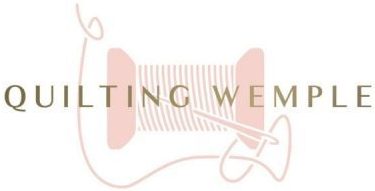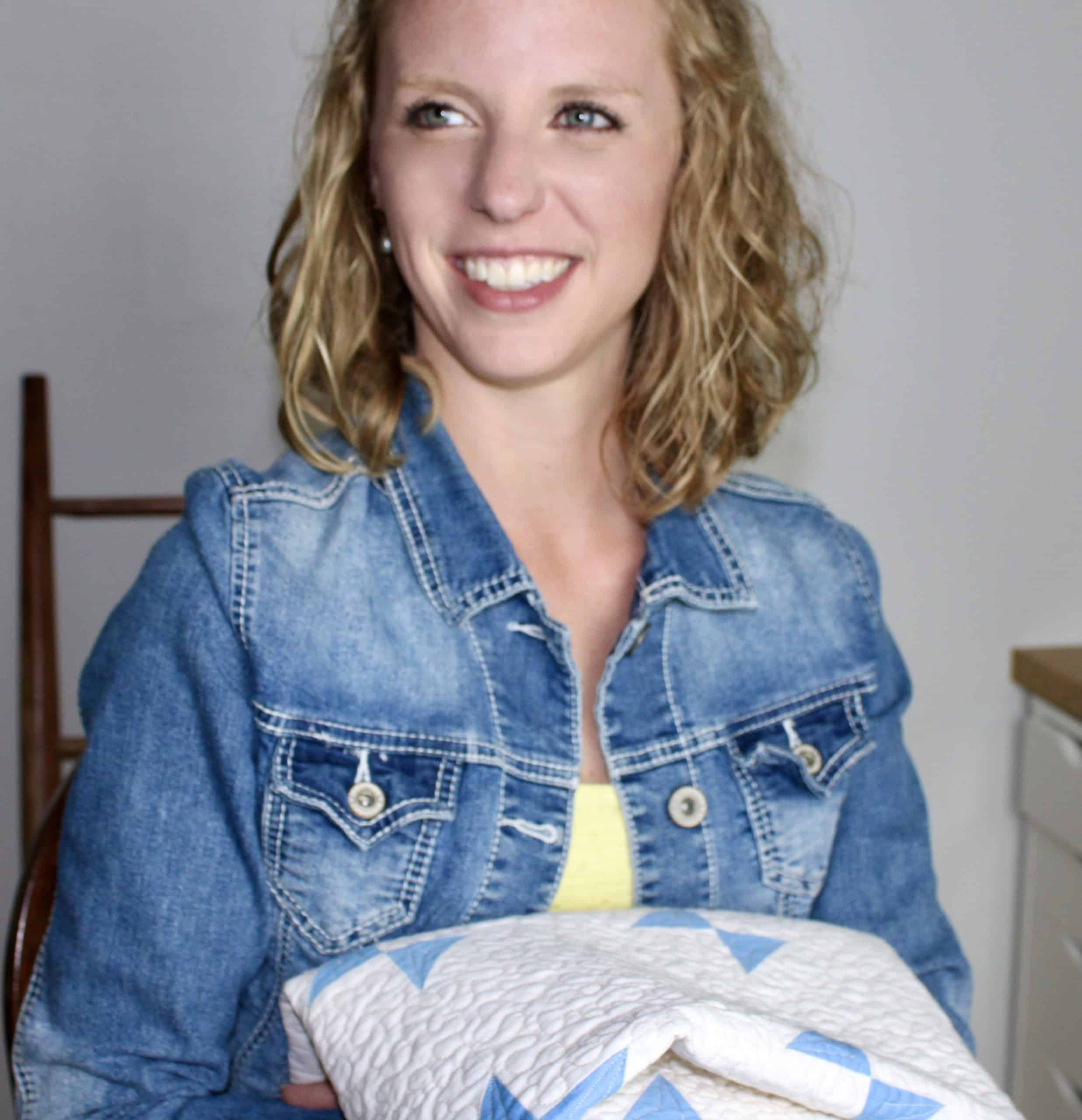
You read it all over the internet, the more accurately you cut the pieces for your quilt, the more accurate your quilt blocks will be.
The more accurate your quilt blocks are, the easier and more technically “perfect” your quilt will be.
When I first started, quilting was like cutting wood for a craft project, what’s 1/16 or 1/8th here or there.
It can’t REALLY make that much of a difference.
Then I started putting together a quilt project to practice the quilting basics which is something I haven’t really put much effort into doing in the past.
Related:
How to Nest Seams
How to Get Perfect Points in Quilting
And after finishing one quilt where I intentionally made an effort to be as accurate as possible and I’m officially sold.
The quilt went together like a dream. I learned an important lesson.
Rounding (or in the quilting world: Inaccuracy) when you square up fabric leads to those same kinds of gaps.
Missing 1/16th here and 1/8th there over a whole quilt adds up and you’ll end up spending a lot of time and effort to hide those gaps between quilt blocks when you put your quilt top together.
Okay fine. So I guess I’ve been convinced that I need to put more effort into learning how to square up fabric.
So how do we go about that?
Cut your fabric down to workable size

Cutting your fabric down makes the piece you are cutting way more manageable.
If you have bad habits like me, your fabric looks like the stack I have in the picture above.
Folding your fabric over and over to get it to a size you can actually see the cutting mat around spells disastrous cutting.
Folding your fabric leads to significantly more risk of cutting inaccuracies depending on how you do it so avoiding doing this will help out immensely.
This part was the biggest corner I’d cut.
“Why should I cut my fabric down? I’m in my 20’s and cheap so obviously I got as little fabric as possible to complete my quilt top.”
If I cut it down before cutting strips for my quilt, I’m creating more waste and am going to have to pay for more fabric and waste time going to get it.”
Then I realized, if I take a hot second to measure what I’m cutting down instead of just hacking it down in random pieces I can minimize this concern (lazy and cheapness really) by a lot.
If I know I need 6 inch strips, I’ll measure and cut my fabric down to 13 inches across and only end up with 1 inch wasted instead of just randomly cutting the fabric down and potentially wasting significantly more.
So step one cut your fabric down to a manageable size, whatever that is for you before you try to square up the fabric.
If you don’t want to pay more money for more fabric, pay in time and just think out how you are going to cut it down first.
It’ll help your quilts be that much better and easier to assemble.
Also, ProTip: This step of the quilting process will go over much quicker and smoother if you have a nice sharp rotary cutter and cutting mat.
Not sure what to look for? This is the rotary cutter I love, and the one cutting mat that is big enough to get me through every quilt so far without being ridiculous to store.
Line up the horizontal edges

Fold your fabric in half (if necessary) and line the fold up with a horizontal line on the cutting mat.
Any raw edges do not need to line up with a horizontal line.
If you have to fold the top down, be sure the fold also follows a second horizontal line on the mat
Be sure you are not folding the fabric any more than twice.
Preferably only once.
But definitely no more than twice when making your strips to cut from.

Why no more than two times?
The only way you can get super accurate cuts is by lining that fabric up against the lines on your cutting mat.
If the folds aren’t lined up perfectly, when you make a vertical cut you will end up with a strip that looks like a “V” when you open it up.
And that means you won’t be able to make a square cut easily. The fabric will always want to be slanted.
And the point in the middle will just end up wasted all together.
You can line up a bottom fold and a top fold. Anything else and you can’t actually see it lined up with lines on your cutting mat.
Since this is your first cut, we don’t care about the raw ends just yet, if they aren’t lined up straight right now it doesn’t matter.
They’ll be cut off later anyway.
So two folds MAX. Less if you can manage it.
Line up the vertical edges and cut

Time to actually square up the fabric.
Now that the horizontal edges are lined up, pull the whole thing over to any vertical line on your cutting mat.
Double check to be sure that all raw vertical edges for all layers of fabric are across the vertical line.
Any where you have a folded edge, double and triple check that they are lined up with horizontal lines on the cutting mat after shifting the fabric.
Using quilting ruler, line edge up with the same vertical line you pushed all of the raw edges just beyond.
Be sure that it lines up with that vertical line not only below your fabric but above it as well.
You want to be able to see that the quilting ruler follows the vertical line beyond both sides of your fabric.
That’s how you know you are super square 🙂
Hold the ruler firmly in place (but be careful not to slide it by accident) and using the ruler as a guide, cut the fabric with a rotary cutter.
When you make this cut, it should be taking off all of the raw edges of your fabric and then some to make a nice straight cut through all of the layers of your fabric.

Scissors are not going to cut it here unfortunately, it’s just too hard to get a perfectly straight line.
Having a good rotary cutter makes learning how to square up fabric a quick process.
And is much easier on the hands.
Looking for a good rotary cutter? This one is the one I’ve been using and love 🙂
When you make the cut with your rotary cutter, be sure that your hand holding the ruler follows the cutter up to keep the ruler exactly in place.
Depending on the size of the fabric you are cutting, you may have to stop cutting to gently walk your hand up the ruler before continuing to cut.
This will keep the ruler sturdy while you cut instead of twisting under your hand as you cut.
Cut all the width you need according to your pattern
For your next cut, using your cutting mat, count the boxes according to the width you need based on where your fabric is currently lined up.
Line your quilting ruler up with the vertical line you need for your necessary width and repeat the cutting process.
This time you do not need to move the edge of the fabric beyond the vertical line, it should be perfectly lined up with the vertical line already!
All you have to do is count your width and cut along the vertical.

Just double check your horizontal lines to make sure they still line up perfectly before cutting.
If they don’t for whatever reason, go ahead and adjust them.
If you have to adjust your horizontal lines, you will need to do a quick cut to re-square the leading vertical edge to get back on track.
Line up your horizontals, pull the fabric just beyond a vertical line, and cut off the edges that don’t line up any more.
It’s worth the extra second it takes to avoid “V” shaped strips, I promise!
So since we’re here, let’s actually cut that fabric down to something we can use for a quilt.
Cutting down to size

Now that you have all of your strips cut to width, you need to cut them down to length!
Take two or three strips that are the same width, unfold them, and line up the perfectly straight long edges up with each one on top of the other to make a stack.
The process for cutting down to length will be the same as the width.
Line up the bottom long straight edge perfectly with a horizontal line on the cutting mat.
This time raw horizontal edges matter, but you only need to worry about one of them since we intentionally cut them parallel to each other.
Depending on your width, it may or may not line up with a second printed line on the mat since they are typically printed at 1″ intervals.
So if you are cutting a strip that’s only 2.5″ wide it naturally won’t reach the 3″ mark. That’s okay.
As long as one edge is lined up it’s all good.
Pull the stack of fabric just beyond a vertical line until all of the raw edges are on the other side.
Line up your quilting ruler with the vertical line and cut off the raw edges.
The edge of your strips should make a perfect square edge with the lines on the cutting mat.

Count over how long you need the piece to be and line up your quilting ruler to start cutting your strips into usable pieces for your quilt.
ProTip: When you have to make cuts that are not at 1″ intervals, be sure to use a long ruler that reaches both ends of your mat like the picture below.

If you use a short ruler and don’t have a line running the full length of the mat to line it up with, you can’t be sure its square, or even the right width you need, like in the picture below.

Just be sure to refer to your pattern for the sizes that you need!
These two rulers are the only two rulers I currently own for squaring fabrics, and they’ve gotten me through pretty much everything.
If you are looking for a minimalist (or cheap) way to get the most versatility for your buck, this 24″x6″ ruler, and this 6.5″ square ruler are pretty much all I use.
And that’s it! That’s all I do to square up fabric and cut it down to size!
Looking for a pattern to practice on? Be sure to check out my new Almost Friday quilt pattern to get started!
And if you liked this tutorial and want more awesome quilty tips and tutorials, don’t forget to follow me below on pinterest!









0 Comments